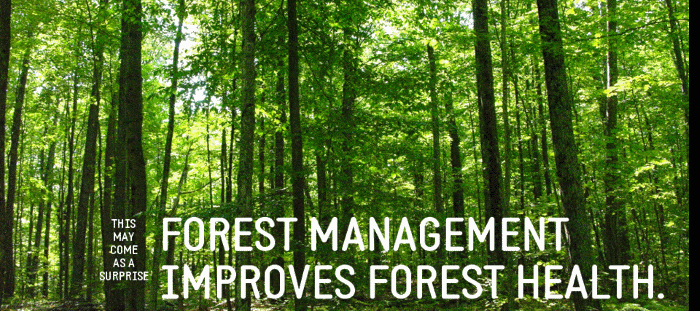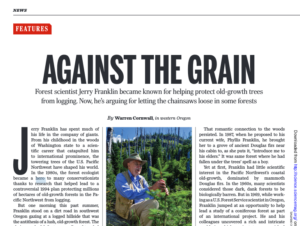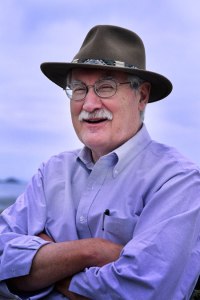Via: https://fabiusmaximus.com/2017/10/16/forest-management-seral-landscape-science/
A story showing why America’s forests are burning
Summary: Why is so much of America burning? We see the answer as much of California burns. Land was stripped of the trees that provided firebreaks, homes were carelessly built in natural fire zones, and decades of fire suppression allowed accumulation of tinder (details here). Scientists warned and were ignored. Here is an account of the next frontier in forest management. Ecologists’ research produces new recommendations — and anti-science greens stage political protests to stop them. It is a story of America’s failure to learn, of America the dysfunctional — because we have dropped the reins.
Excerpt from “Against the grain” Published in Science Magazine:
By Warren Cornwall at Science, 6 Oct 2017.
Links and color emphasis added. The money paragraphs are at the end.Work of an eminent scientist.
“Jerry Franklin has spent much of his life in the company of giants. …In the 1980s, the forest ecologist became a hero to many conservationists thanks to research that helped lead to a controversial 1994 plan protecting millions of hectares of old-growth forests in the Pacific Northwest from logging. …
“In …1969, while working as a U.S. Forest Service scientist in Oregon, Franklin …and his colleagues uncovered a rich and intricate world, in which ancient trees nourished new life with fallen logs, cleansed salmon-filled streams, and provided habitat for a menagerie of life, including lichens, rodents, and owls.
“As that picture coalesced in the 1970s, it coincided with the stirrings of opposition to the logging industry that relied on old-growth forests. The so-called “Timber Wars” of the 1980s and early ’90s pitted environmentalists wielding lawsuits and civil disobedience against federal officials and timber firms. Efforts to protect the northern spotted owl, an old-growth denizen, became a centerpiece of the conservation campaign … Franklin’s scientific work backed a broader argument: that logging was dismantling the foundations of a vibrant ecosystem that nurtured far more than just the owl.
“At one point, environmentalists obtained a draft of a Franklin-led Forest Service report and distributed copies, fearing the agency’s leaders would bury it. The document “was like a bible,” says Andy Kerr, an environmental activist based in Ashland, Oregon, who heads the consulting firm The Larch Company. …
“As the conflict peaked, Franklin, by then a professor at the University of Washington, found himself at the center of an intense political struggle that featured bumper stickers advising: “Save a logger, eat an owl.” In 1991, at the request of Congress, Franklin and three other leading forest scientists spent 6 weeks holed up in Portland, Oregon, crafting a sweeping plan to protect federal old growth across western Washington and Oregon, as well as northern California. The work of what became known as the “Gang of Four” served as the template for the final Northwest Forest Plan adopted by then-President Bill Clinton. …
“It essentially halted logging in federally owned old-growth forests — generally defined as having trees older than 180 years — on federal lands. It also protected 4 million hectares of mixed old-growth and previously logged lands. The amount of wood coming out of federal forests fell from nearly 12 million cubic meters per year in the late 1980s to a 10th of that in recent years. As the saws went silent, many small mill towns withered.
“Even before the forest plan was signed, however, Franklin had embarked on new research that has led him to question some of its management approaches. …
The next generation of research about forest management.
“In 2011, a group of prominent forest experts, including Franklin, wrote a paper aimed at calling attention to early seral forest, which they labeled “the forgotten stage.” They urged caution about logging and replanting trees after wildfires, arguing that a complex, scrubby ecosystem should be allowed to develop without interference. …”
“Franklin and Johnson have concluded that logging in federal forests could be a valuable tool for creating new patches, particularly in coastal Pacific Northwest tracts now densely packed with replanted Douglas firs. Natural promoters of seral habitat, such as storms and fires, are relatively rare in the region, Franklin notes in his argument for a more hands-on approach. And logging would have a side benefit, he says, by helping the hard-hit industry. Franklin now touts a formula for creating seral habitat that calls for logging about two-thirds of the trees on a tract, and doing no replanting. …”
The paper is “The forgotten stage of forest succession: early-successional ecosystems on forest sites” by Mark E Swanson and Jerry F. Franklin et al. in Frontiers in Ecology and the Environment, March 2011. It concerns the vital role of early seral landscapes in forests (a kind of seral community). For an introduction see “The forgotten forest” by Tim Steury in Washington State Magazine.
A follow-up paper is “A Restoration Framework for Federal Forests in the Pacific Northwest” by Jerry F. Franklin and K. Norman Johnson in the Journal of Forestry, December 2012. See this graphic from the Science article (click to enlarge).
The greens respond to science.
“The debate has grown more charged as Franklin has turned his ideas into on-the-ground action. In 2013, after Franklin and Johnson teamed up with the federal Bureau of Land Management (BLM) for a small logging experiment near Roseburg, Oregon, protesters camped out for months among the limbs of the largest trees — some a century old — to block the project. Two years later, a federal judge sided with the opponents, ruling BLM hadn’t fully studied the environmental impacts.
“For Johnson, the fight took a personal toll. On a road near his home in Corvallis, activists erected a billboard showing a swath of logged BLM land, denouncing it as a ‘Johnson & Franklin’ project. He says some people started avoiding him in coffee shops in the town, home to OSU and a center of forest research. ‘It was unbelievable,’ he recalls.”
Johnson and Franklin wrote an op-ed in the Register-Guard explaining that the billboard was inaccurate. As if the greens care about the facts, or science.
Conclusions
This is an example on a small scale (so far, at least) of scientists attacked by political activists on the left. Larger examples are the jihads against Professor Roger Pielke Jr. (here, here, and here), Roger Pielke Sr., and Dr. Judith Curry…This problem appears to be growing worse, as greens become increasingly active against science whose conclusions they do not like — as the left becomes increasingly active on colleges suppressing speech they do not like (recent examples: calls to fire Professor Scott Yenor at Boise State U). and professor Bret Weinstein at Evergreen State College).
We depend on science to help us manage an increasingly complex world. Rapid progress is our best hope to avoid the dystopian scenarios that Hollywood shows us for the 21st century. That will not happen if we listen to political activists attacking science that does not fit their ideology.
About Jerry Franklin
Jerry Franklin is a professor of environmental and forest sciences at the U of Washington in Seattle. See his profile and publications. It is an impressive list of accomplishments and awards. To mention a few…
In 2004 the Society for Conservation Biology gave him its Edward T. LaRoe III Memorial Award. “Given to an individual who has been a leader in translating principles of conservation biology into real-world conservation. In 2005 he received the Heinz Award for the environment.
In 2016 the Pinchot Institute for Conservation awarded him its Pinchot Medallion, which honors “an individual who has made extraordinary and valuable contributions to science or practice in environmental conservation and sustainable natural resources management.” The award is named for Gifford Pinchot, the first leader of the U.S. Forest Service and an advocate for conservation.
The Ecological Society of America named name him its “Eminent Ecologist” of 2016. It honors an ecologist who has made significant, long-standing contributions to the field of ecology.
For More Information
If you liked this post, like us on Facebook and follow us on Twitter. For more information see posts about the keys to understanding climate change and these the march of science…
- Are 30 thousand species going extinct every year?
- Good news about polar bears, thriving as the arctic warms!
- Good news about CO2 emissions. Progress to a better world.
- A climate science milestone: a successful 10-year forecast!
- Cut thru the myths about Irma, Harvey, and climate change.
A tale of America’s mismanagement of its natural areas, ignoring scientists.

Playing God in Yellowstone: The Destruction of America’s First National Park by Alston Chase tells the story about our generations of mismanagement of Yellowstone Park, jewel of the National Park system. Recommendations by scientists were frequently ignored — resulting in waves of well-intentioned slaughter of wildlife and a distorted ecosystem.
Chase was chairman of the Department of Philosophy at Macalester College in Minnesota, with degrees from Harvard, Oxford and Princeton Universities. He has written incisive books on several subjects..






